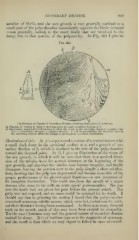Page 859 - My FlipBook
P. 859
SECONDARY DENTINE. 869
number of fibrils, and the new growth is very generally confined to a
small part of the pulp-ehaniber immediately opposite the fibrils irritated
—not generally, indeed, to the exact fibrils that are involved in the
decay, but to that portion of the pulp-cavity. In Fig. 464 I gis^e an
Fig. 464.
Calcification, or Deposit of Secondary Dentine, resulting from caries of an incisor.
A, Diagram of Section of Incisor, showing caries at a, and secondary dentine at li.
B, Illustration, magnified 2Ui) diameters, to show the tissue of tlie secondary dentine: a, pulp-rbani-
ber; 6, h, secondary dentine; c, primary dentine. It will be noticed that the dentinal tubes in
the secondary dentine gftidually disappear, giving place to a clear calcification.
illustration of this. At A is represented a section of a central incisor with
a small dark decay in the proximal surface at «, and a growth of sec-
ondary dentine at 6, which is confined to the side of the pulp-chamber
toward the decayed point. At B, I give an illustration of the tissue of
the new growth, in which it will be seen that there is a marked diver-
sion of the tubules from the normal direction at the beginning of the
new growth, and also that the tubules soon become irregular, and finally
disappear, leaving the portion next to the pulp simply a clear calcifica-
tion, showing that the pulp has degenerated and become incapable of the
proper performance of its physiological functions—a sure precursor of
its complete destruction. This tooth was from the mouth of a negro
woman who came to me with an acute apical pericementitis. She was
sure the tooth had not given her pain before the present attack. The
pulp was not exposed, and no cause could be assigned for its death. I
should say that in grinding the section I found that the pulp-chamber
contained numerous calcific masses, which were lost, unfortunately, with-
out their character having been ascertained. As there were many decayed
teeth in the mouth, much of this may have been excited by sym]xathy.
Yet the case illustrates very well the general nature of secondary dentine
excited by decay. It is of medium type as to the regularity of structure,
and the result is that which we may expect to follow in ca.ses of consid-


